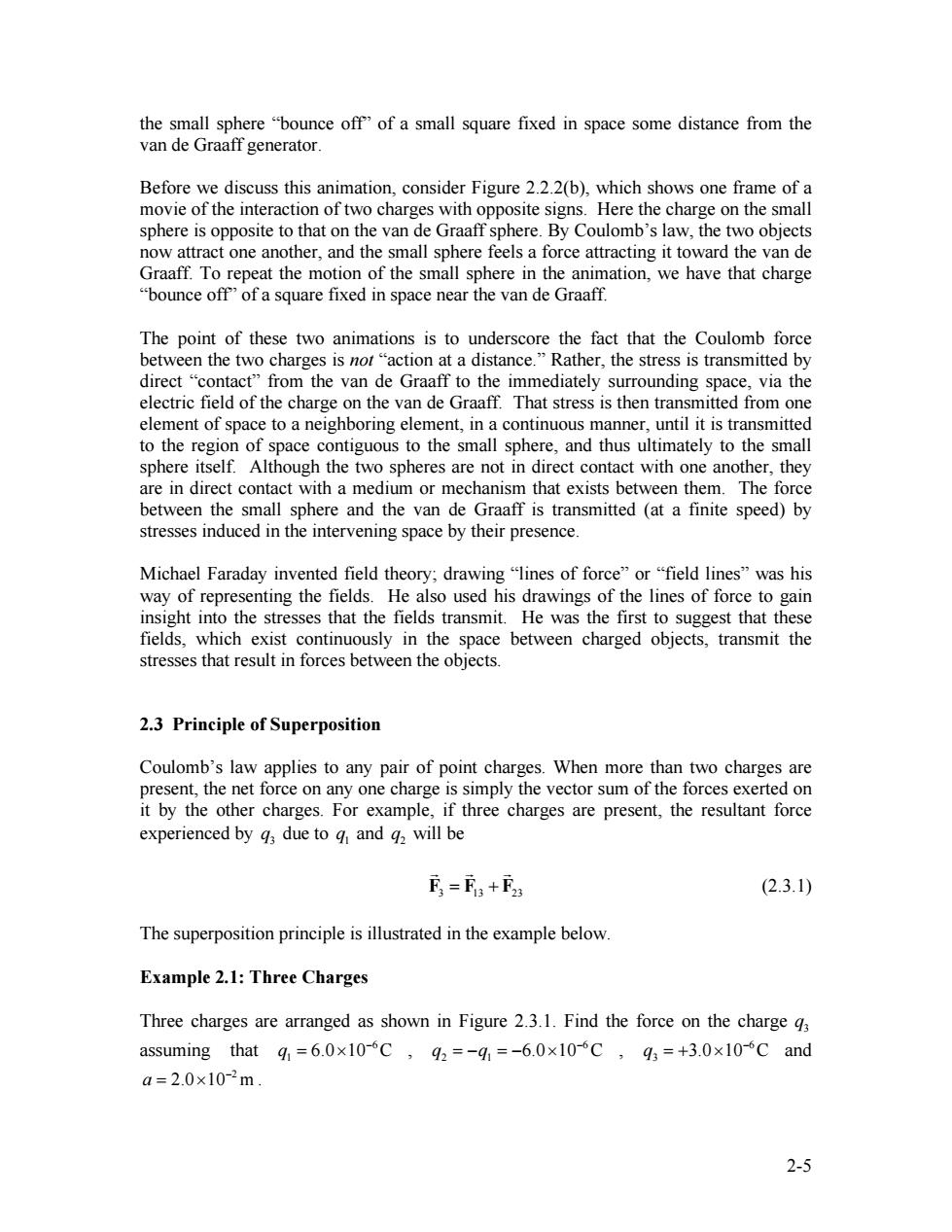正在加载图片...

the small sphere "bounce off'of a small square fixed in space some distance from the van de Graaff generator. Before we discuss this animation,consider Figure 2.2.2(b),which shows one frame of a movie of the interaction of two charges with opposite signs.Here the charge on the small sphere is opposite to that on the van de Graaff sphere.By Coulomb's law,the two objects now attract one another,and the small sphere feels a force attracting it toward the van de Graaff.To repeat the motion of the small sphere in the animation,we have that charge "bounce off'of a square fixed in space near the van de Graaff. The point of these two animations is to underscore the fact that the Coulomb force between the two charges is not "action at a distance."Rather,the stress is transmitted by direct "contact"from the van de Graaff to the immediately surrounding space,via the electric field of the charge on the van de Graaff.That stress is then transmitted from one element of space to a neighboring element,in a continuous manner,until it is transmitted to the region of space contiguous to the small sphere,and thus ultimately to the small sphere itself.Although the two spheres are not in direct contact with one another,they are in direct contact with a medium or mechanism that exists between them.The force between the small sphere and the van de Graaff is transmitted (at a finite speed)by stresses induced in the intervening space by their presence. Michael Faraday invented field theory;drawing "lines of force"or "field lines"was his way of representing the fields.He also used his drawings of the lines of force to gain insight into the stresses that the fields transmit.He was the first to suggest that these fields,which exist continuously in the space between charged objects,transmit the stresses that result in forces between the objects. 2.3 Principle of Superposition Coulomb's law applies to any pair of point charges.When more than two charges are present,the net force on any one charge is simply the vector sum of the forces exerted on it by the other charges.For example,if three charges are present,the resultant force experienced by g3 due to g and g2 will be F3=F3+F23 (2.3.1) The superposition principle is illustrated in the example below. Example 2.1:Three Charges Three charges are arranged as shown in Figure 2.3.1.Find the force on the charge gs assuming that g=6.0×10-6C,q2=-q,=-6.0×10-6C,q3=+3.0×10-6Cand a=2.0×10-2m. 2-5the small sphere “bounce off” of a small square fixed in space some distance from the van de Graaff generator. Before we discuss this animation, consider Figure 2.2.2(b), which shows one frame of a movie of the interaction of two charges with opposite signs. Here the charge on the small sphere is opposite to that on the van de Graaff sphere. By Coulomb’s law, the two objects now attract one another, and the small sphere feels a force attracting it toward the van de Graaff. To repeat the motion of the small sphere in the animation, we have that charge “bounce off” of a square fixed in space near the van de Graaff. The point of these two animations is to underscore the fact that the Coulomb force between the two charges is not “action at a distance.” Rather, the stress is transmitted by direct “contact” from the van de Graaff to the immediately surrounding space, via the electric field of the charge on the van de Graaff. That stress is then transmitted from one element of space to a neighboring element, in a continuous manner, until it is transmitted to the region of space contiguous to the small sphere, and thus ultimately to the small sphere itself. Although the two spheres are not in direct contact with one another, they are in direct contact with a medium or mechanism that exists between them. The force between the small sphere and the van de Graaff is transmitted (at a finite speed) by stresses induced in the intervening space by their presence. Michael Faraday invented field theory; drawing “lines of force” or “field lines” was his way of representing the fields. He also used his drawings of the lines of force to gain insight into the stresses that the fields transmit. He was the first to suggest that these fields, which exist continuously in the space between charged objects, transmit the stresses that result in forces between the objects. 2.3 Principle of Superposition Coulomb’s law applies to any pair of point charges. When more than two charges are present, the net force on any one charge is simply the vector sum of the forces exerted on it by the other charges. For example, if three charges are present, the resultant force experienced by due to and will be 3 q 1 q 2 q F F 3 1 = +3 F23 G G G (2.3.1) The superposition principle is illustrated in the example below. Example 2.1: Three Charges Three charges are arranged as shown in Figure 2.3.1. Find the force on the charge assuming that , , and . 3 q 6 1 q 6.0 10 C− = × 6 2 1 q q 6.0 10 C− = − = − × 6 3 q 3.0 10 C− = + × 2 a 2.0 10 m− = × 2-5